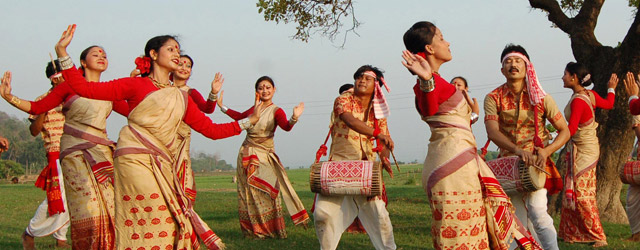The festival of Bihu is never complete without the traditional Bihu Dance. This root of this form of colourful and vibrant dance is still unknown. The earliest possible documented history of Bihu dance dates back to the time of Ahom King Rudra Singha who invited a group of Bihu performers to perform the dance in the year 1694 at Ranghar fields on the occasion of Rangoli Bihu. The occasion is celebrated during the month of mid-April, which also marks the beginning of the Assamese New Year.
The Bihu dance is quite an energetic form of dance that involves rapid hand and feet movement. The dance emphasises more of the role of the women and the female members maintain a tighter line of movement in comparison to the men folks. Typically in a Bihu dance the men folk enter the stage followed by the female performers. The dance moves are choreographed keeping in mind the roles of both of both the genders.
A Bihu dance performance is never completed without music and the drummers play a vital role during the performance. They usually play a twin faced drum at the very beginning of the performance and set the stage. Flutes made from bamboos are also frequently used in Bihu performances. Other instruments which are used during the performance include a dhol, Taal, toka, xutuli, pepa, gogona and baanhi.
Bihu performers wear traditional jewellery and clothes during the performance. The male performers wear a dhoti and a gamcha. The dhoti is a piece of cotton cloth with a simple or gorgeous border that is used to cover the lower part of the body. The gamocha is usually worn on the waist or head. The striking colours of the dress make the dance look all the more vibrant and enjoyable. The women performers wear Chador and Mekhala. The Mekhala is like a drape that is used for covering the lower portion of the female body, while the chaddar is worn on the upper part of the body. The attires of the women are usually made from silk, cotton or muga silk, depending on the choice of the performer.
A traditional Bihu dance is a real spectacle and performers of Bihu are invited to showcase their skills in different international platforms.









